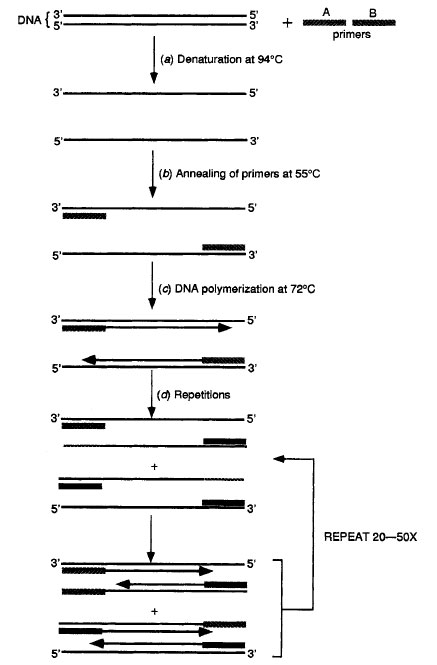The Polymerase Chain Reaction
The replication of genetic material is carried out by enzymes called DNA polymerases. These enzymes initiate the synthesis of DNA starting from a primer bound to a template. The primers are generally 9 to 25 bases in length and establish the site where DNA replication begins. With the polymerase chain reaction (PCR), any particular stretch of genetic material can be pinpointed and replicated numerous times simply by selecting a pair of primers that flank the desired stretch of DNA . The PCR is predicated on the annealing of two oligonucleotides (primers) of known composition to a target sequence of interest and the extension of the oligonucleotides with a DNA polymerase. Each reaction is repeated subsequent to a denaturation step, thus allowing for exponential amplification.The PCR (Figure 9-3) involves three temperature incubations or steps that are repeated 20-50 times. One repetition of three steps is called a cycle. In the first step, called denaturation, the two strands of the target DNA molecule are separated (denatured) by heating the DNA to 94°C to break the hydrogen bonds between bases, yielding two separate strands. In the second step, called annealing, two primers hybridize to complementary sequences in the single strands. The primers are short (20-30 bases in length), synthetic stretches of single-stranded DNA . They are selected so that one primer is complementary to one end of the gene of interest on one strand, while the second primer is complementary to the opposite end on the other strand. The primers form hydrogen bonds with (anneal to) their complementary sequences, forming stable, doublestranded molecules. Annealing temperatures range between 37 and 60°C. During the third step, extension, or elongation, the primers are extended by a thermostable DNA polymerase at 72°C.
 |
| Figure 9-3 Schematic representation of a typical PCR assay. |
To study the effects of mutations on gene expression, researchers have developed a technique known as site-directed mutagenesis, which introduces point mutations at specific sites. One of the most commonly used strategies takes advantage of primer-directed amplification of DNA to introduce mutations. One of the primers is designed with a sequence complementary to the region in the target DNA , but with the desired substitution, insertion, or deletion. The mutagenic sequence within the primer must be either at the 5' end of the primer or internal to the primer, but never at the 3' end of the mutagenic primer. The 3' end of the mutagenic primer (at least 6-10 bp long) must be totally complementary to the target DNA to permit full annealing of the primer to its target and allow the polymerase to extend the primer. The PCR is carried out initally (first 5-10 cycles) under low stringency conditions, to allow the mismatch to occur. Once a few mutagenized templates are produced during the PCR, these will serve as targets and will be fully complementary to the primer. The end products will contain the mutation at the desired site.
Notes
The steps of PCR:
Denaturation
Annealing
Extension




